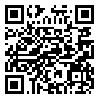Volume 12, Issue 3 (12-2020)
2020, 12(3): 47-55 |
Back to browse issues page
Download citation:
BibTeX | RIS | EndNote | Medlars | ProCite | Reference Manager | RefWorks
Send citation to:



BibTeX | RIS | EndNote | Medlars | ProCite | Reference Manager | RefWorks
Send citation to:
Abbaspour H, Karimi Moonaghi H, Kareshki H. The Hidden Curriculum and Its Role in Medical Sciences Education Under the Skin of the Curriculum. North Khorasan University of Medical Sciences 2020; 12 (3) :47-55
URL: http://journal.nkums.ac.ir/article-1-2157-en.html
URL: http://journal.nkums.ac.ir/article-1-2157-en.html
1- PhD Candidate, Department of Medical Surgical Nursing, School of Nursing and Midwifery, Mashhad University of Medical Sciences, Mashhad, Iran.
2- Professor, Nursing and Midwifery Care Research Center, Department of Medical Surgical Nursing, School of Nursing and Midwifery, & Department of Medical Education, School of Medicine, Mashhad University of Medical Sciences, Mashhad, Iran ,karimih@mums.ac.ir
3- Associate Professor of Educational Psychology, Faculty of Educational Sciences and Psychology, Ferdowsi University of Mashhad, Iran
2- Professor, Nursing and Midwifery Care Research Center, Department of Medical Surgical Nursing, School of Nursing and Midwifery, & Department of Medical Education, School of Medicine, Mashhad University of Medical Sciences, Mashhad, Iran ,
3- Associate Professor of Educational Psychology, Faculty of Educational Sciences and Psychology, Ferdowsi University of Mashhad, Iran
Abstract: (4284 Views)
Introduction: In addition to formal and explicit curriculum, we have another type of curriculum that is called hidden or implicit curriculum, and has various positive or negative effects and consequences on our learners' attitudes, behaviors, behaviors, and personalities. There are many definitions of hidden curriculum structure and its dimensions, but there is still no theoretical agreement on it. This study aimed to determine the different dimensions of hidden curriculum and its role in medical education.
Methods: This article provides a comprehensive overview of the literature inside and outside the databases; CINHAL ،MEDLINE ،Web of Sciences ،Google Scholar ،
Ovid ،Iran Medex ،Magiran ،SID and The search was done keywords related to the
hidden curriculum; "tacit curriculum”, “hidden curriculum”, “Informal curriculum”,
“medical education” without time and with the logical operators AND, OR, NOT,
and few studies were found in the field of medical education. The study reviewed
studies by 2020 and was excluded unrelated or full-text articles.
Results: The hidden curriculum from different perspectives came with many different definitions. Experts have taken note of each particular angle. In this respect, numerous approaches and theories have emerged from the hidden curriculum. From these theories, nature theory, dimensional theory, factor theory, and consequence theory were discussed.
Conclusions: So we believe that the university should ideally incorporate a hidden curriculum for education; develop a spirit of thinking and research, fairness and respect for scientific facts, interest in research and problem solving, training of thoughtful and divergent minds, respect for science. Strive for the sake of science itself, not for profit purposes, nurturing creative human beings, understanding the need for lifelong learning, reinforcing scientific identity and central ethics in academia.
Methods: This article provides a comprehensive overview of the literature inside and outside the databases; CINHAL ،MEDLINE ،Web of Sciences ،Google Scholar ،
Ovid ،Iran Medex ،Magiran ،SID and The search was done keywords related to the
hidden curriculum; "tacit curriculum”, “hidden curriculum”, “Informal curriculum”,
“medical education” without time and with the logical operators AND, OR, NOT,
and few studies were found in the field of medical education. The study reviewed
studies by 2020 and was excluded unrelated or full-text articles.
Results: The hidden curriculum from different perspectives came with many different definitions. Experts have taken note of each particular angle. In this respect, numerous approaches and theories have emerged from the hidden curriculum. From these theories, nature theory, dimensional theory, factor theory, and consequence theory were discussed.
Conclusions: So we believe that the university should ideally incorporate a hidden curriculum for education; develop a spirit of thinking and research, fairness and respect for scientific facts, interest in research and problem solving, training of thoughtful and divergent minds, respect for science. Strive for the sake of science itself, not for profit purposes, nurturing creative human beings, understanding the need for lifelong learning, reinforcing scientific identity and central ethics in academia.
Type of Study: Review Article |
Subject:
Basic Sciences
Received: 2020/01/20 | Accepted: 2020/06/14 | Published: 2020/12/30
Received: 2020/01/20 | Accepted: 2020/06/14 | Published: 2020/12/30
Send email to the article author
| Rights and permissions | |
 |
This work is licensed under a Creative Commons Attribution-NonCommercial 4.0 International License. |






